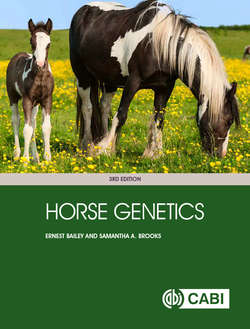Читать книгу Horse Genetics - Ernest Bailey - Страница 41
На сайте Литреса книга снята с продажи.
Оглавление4 The Fundamentals of Genetics
Genes behave in very predictable ways. In fact, working with genetics can be fun and rewarding for those people who have logical thinking skills and enjoy playing sleuth. Many horse breeders will enthusiastically take on the task of learning about genetics, especially for the breed they have chosen, but interest in horse genetics is not limited to people with a breeding program. Buyers, even if not planning to breed horses, need to know what may and may not be reasonably expected. Horse owners may be fascinated to learn how one favorite steed comes to be distinctive in color, size, shape, or ability from another.
A horse show provides a good opportunity to compare characteristics that identify individual horses as belonging to a particular breed. The most conspicuous differences among breeds include color, size, gait, and carriage. Horse breeds are developed with very specific goals in mind and horses are often closely related or highly selected for the same genetic traits. Despite the action of selection, variation continues to exist. Judges still manage to award ribbons of different colors at horse shows. Even the casual observer can discern the close relationship among, for example, Arabian horses and distinguish them from groups of Thoroughbred horses, Quarter horses and Friesian horses. Horse breeders had an intuitive sense of genetics guiding them to create the diversity of breeds that exist today. However, the horse is not an ideal model for studying genetics.
In 1866, the Austrian monk Gregor Mendel determined the principles of genetics from work using garden peas. Subsequently, scientists proved that Mendelian genetic principles apply to the inheritance of traits in animals as well as in plants. The aim of these next two chapters is to describe the basic principles of Mendelian genetics using horses, not peas, as examples. But first, let us consider the nature of genes.
